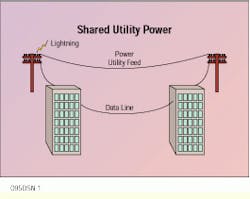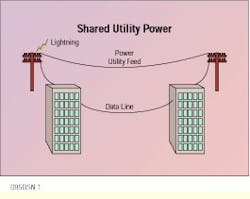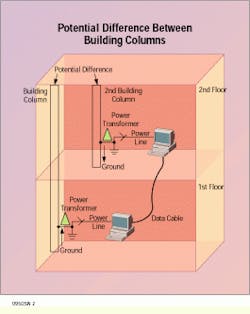Grounding and bonding ensure a safe installation
Equipment damage is more often caused by differences in voltage than by surges in current.
Mark Waller
The Waller Group Inc.
It may seem difficult to think in terms of voltage surges instead of current surges. In fact, current from lightning or another high-energy event would probably vaporize most data lines. Transient voltages (ground potential rise), which appear throughout the ground path itself, cause more damaged equipment, lockups and garbled data than any other phenomenon. Current flowing in power circuits, grounds from in-rush, short circuits and lightning cause transient voltages. Understanding that grounding and bonding are used to equalize the potential differences in the grounding system that serves as the reference for data can give you a good start toward a cleaner environment for data and telecommunications transmission.
The following happened several years ago and shows how a number of bizarre and unplanned events can suddenly conspire to reveal a grounding problem. An operator wearing a telephone headset was using her computer when, outside the building, a backhoe operator accidentally cut through the incoming power cable to the building, creating a momentary short circuit. The operator was instantly knocked off her chair. What happened? The short circuit had created an electrical potential (voltage) difference between the power system ground and the phone system ground. What was perplexing was that the headset worn by the operator had ear tubes made of plastic, so how had this potential difference appeared across the hapless operator?
That question drew experts in power quality and grounding to investigate. It was discovered that the operator had a new headset, which had a residual of moist, conductive material (that eventually would have evaporated) left on it from the manufacturing process. Therefore, for a short time after being removed from its sealed package, the plastic tubes were conductive, creating a complete circuit from the computer--where the operator touched the electrical power grounding system--and her ears--at that time, part of the telephone system ground.
What does this anecdote have to do with installers? You know that grounding is essential to ensure the safety of building personnel; however, what you may not know is how poor grounding practices can come to light. Understanding standards and safety requirements is essential; but knowing building and electrical codes and standards is not enough. Not knowing how grounding works can lead to faulty installations with operational problems. It can also leave you without options when things do not go right. First, it is important to understand the difference between voltage and current.
Voltage vs. current
Imagine a truck roaring down a country road. You could probably see the dust rising from a mile away. In this example, the truck represents current, and the dust voltage. What if the truck started from a dead stop, accelerated to top speed and then leveled off at that top speed? The act of acceleration would probably raise quite a rooster tail of dust. Of course, you would have more dust (voltage) if the truck (current) went 60 miles per hour as opposed to 30 miles per hour. Current creates voltage.
From Ohm`s law, current flowing through a conductor creates a voltage drop along the conductor proportional to the resistance or impedance of the wire. Because impedance is proportional to frequency, current flowing at 60 hertz (30 mph in our example)--the frequency of utility power--will create a smaller voltage drop than current flowing at 10 megahertz (60 mph). In addition, a greater voltage drop is created when the current starts at zero and increases to a high level in a very short time--just as when the truck accelerates quickly. This concept is known as rise time, or the time it takes for current to go from minimum to maximum level. Voltage drops created by current flow are directly related to either frequency or rise time.
Voltage drops in the real world
In the real world, 60-Hz current does not cause voltage drops of any consequence where grounding is concerned. That is not to say that 60-Hz current does not present a grounding problem. For example, if you have a data cable running between two buildings, the ground reference for these two buildings will almost never be the same. Current will flow in the grounded shield of the data cable proportional to the voltage difference between the two buildings. This is a classic example of a ground loop.
To solve this problem, the circuit between the two buildings must be opened or blocked by preventing the flow of current through the cable--using modems or opto-isolators, for example. Lifting the shield is not recommended because doing so can create dangerous voltages between the shield and ground at either cable end.
An often-cited example of voltage drops caused by a change in frequency involves high-frequency noise current flowing in the grounding system, data cable grounds and drains because of ground loops. This occurrence is rare, however.
Finally, our truck analogy illustrates the idea of current rise time causing voltage drops. Lightning is a good example of this concept. The typical lightning strike has current of approximately 20,000 amps peak, but sometimes can go higher. This current only takes 50 to 200 nanoseconds to go from zero to peak, a phenomenally short rise time. Imagine that truck driving down a country road!
Lightning strikes are rare, but fast rise time current comes from something that happens every day, every hour and every minute in every building. That something is called in-rush current. When you start up a motor, it draws six to 10 times its normal running current for one-half cycle to as long as 10 seconds. This in-rush current flowing down a conductor creates a voltage drop, which will lift local power circuits with respect to ground, or it can lift local ground with respect to other parts of a building`s grounding structure. This is not a problem unless you have a personal computer network with data cables strung around the building.
In fact, many devices have large amounts of in-rush current; for example, copiers, laser printers, microwave ovens, furnaces, air conditioners and other electronic devices. All these devices are like that truck on the dirt road: They create voltage or electrical potential differences that constantly push and pull the ground reference of a building.
Voltage drives current
The important point is that lightning current, in-rush current and such isolated events as short-circuit current will always be with us. The net result is unwanted potential differences appearing in the power/signal/safety grounding structure. And, just as current creates these voltages, voltage differences drive current, and this phenomenon is the real impetus behind grounding and bonding. If these potential differences are not managed, they will present themselves across communications devices, data lines and computers in such a way that processing will be disrupted and equipment may be damaged.
Remember that voltage drives current. Another term for voltage is electromotive force--force or pressure applied by voltage. And it is electrical overstress that can damage devices.
In other words, voltage differences will apply pressure to drive current through circuits. If this potential difference appears across a weak component such as a line driver chip, the chip has only a few microns of material with which to resist or stop the flow of current. Should the pressure of voltage across the substrate of this chip succeed in breaking down the substrate, then current will flow and the chip will be destroyed. This does not have to be megavolts either: Some devices will fail at approximately 40V of potential difference, some at even less.
Lightning and in-rush current are always creating current flows inside a building or between buildings. While breaking up loop current may be necessary to solve operational problems, a much more pervasive grounding problem is the potential difference created by current flow.
For example, think of the line driver chip as a person (with two legs). One "leg" is referenced to power ground via the metallic chassis of the device where it is mounted. The other "leg" is referenced to signal ground or the signal itself, depending on the protocol being used. A nearby current event suddenly lifts power ground with respect to data ground. This might be a lightning strike, a motor starting or a copier cycling. Instantaneously, a voltage or a potential difference appears between the "legs" of the chip.
Now change your thinking a little. Visualize that you have a transient-voltage surge suppressor connected from the power lines to ground. Let`s assume that instead of ground current creating the voltage difference, a potential difference appears from one of the power lines and ground. If this differential is high enough--that is, a power surge--the surge suppressor will be activated and surge current will be diverted to ground. This current flow will create a voltage drop that will cause the local ground to lift with respect to the ground structure some distance away. This ground potential rise will be seen across the line driver chip just as it would have had it been created by lightning or in-rush current.
You probably think it odd that a power-line surge suppressor could be the cause of data-communications port failures, but this can happen in a network environment.
One thing you can do to solve this problem is to bond all the data lines to ground. Doing this will have the unfortunate side effect of shorting out the data signal; but it would short-circuit any damaging potential difference that might appear across the chip. Fortunately, there are devices that will essentially equalize any potential differences, and these are data-line surge protectors. These surge protection devices have clamping levels well below the destruct voltage of the chips.
This concept of bonding can be carried throughout the facility. In essence, what you are doing is creating a ground loop. Let`s say you have two building columns that have a potential difference between them every time the air-conditioning system starts up. Suppose that the building is served by two power transformers--one on the first floor and one on the second--fed from the common utility mains in the basement. Assume also that each transformer serves a breaker panel where power is fed to a computer. At least one computer on the second floor is networked to a computer on the first floor. The National Electrical Code requires that these transformers be referenced to building steel--a common ground. However, these columns are not always at the same ground potential with respect to one another. When this potential difference appears, the ground reference of the computers on one floor is raised with respect to computers on another floor. In fact, these references are probably jumping around a bit all day long as devices turn on and off.
If the potential difference is large enough, the network interface card may be irreparably damaged. In this instance, you could install a supplemental grounding strap between the columns in some convenient place--the roof, for instance. This strap may be short enough to provide a low-impedance path between the two columns, thereby equalizing any voltage or potential difference between them. This is one example where bonding forms a ground loop to equalize potential and loop unwanted ground current away from sensitive devices.
What is optimal in a raised-floor computer room? If you tie all of the raised-floor pedestals together with bonding straps and then tie all of the computer cabinets to the raised floor, you create equal potential inside the room from 60 Hz to frequencies above 10 MHz.
Consider the telephone operator example: It is a violation of the electrical code not to ground the electrical system and the phone system together. This is a safety concern; but you can make the environment safer and a lot less electrically noisy by installing supplemental bonding. In the phone room, you can strap racks together or you can bond electrical boxes to raceways. The more bonding you do, the more the entire grounding system is held at the same potential with respect to other areas of the grounding system. In fact, if you lay the data cables in raceways that are properly grounded and bonded, noise is actually decoupled out of shields and drains. In addition, you should always ground the cable-carrying conduit at both ends.
Assume that you have grounded and bonded and you still get damaged communications ports. There is one product that will solve a grounding problem--a data-port protector. All the grounding and bonding in the world, however, will not prevent ground potential differences where network or telephone cables extend over long distances, between floors and especially between buildings. To equalize potential differences at the most vulnerable point in the system, data-port protectors are a must at both ends of the data line.
Will the action of a data-port transient-voltage surge suppressor cause ground potential rise? The answer is yes. For that reason, ground paths for energy discharge must be kept extremely short. A device with a rating of 10V may have an actual clamping voltage of 50V if the discharge path is 6 feet of ground wire. For this reason, mount data-port protectors directly on the protected device. This will ensure that potential differences are equalized between data lines and equipment ground reference. Thus, the subsequent current flow from the actions of the surge suppressor will not create additional voltage differences.
A Few Definitions
Bonding: Interconnecting metallic parts designed to maintain a common electrical potential.
Grounding: Establishing a connection to a metallic structure that serves in place of the earth.
Ground potential rise: A conceptual term that describes how an electrical event can cause a part of the grounding structure to appear instantaneously at a different potential with respect to some other point within the same grounding structure.
Surge: A subcycle disturbance of the AC waveform.
Transient: See surge.
Voltage or potential difference: A voltage that can be measured from one conductor to another.
Voltage, electrical potential and electromotive force are three phases that describe the same phenomenon of electricity.
Both the distance involved and the way utility power is fed (that is, through different substations) ensures that these two buildings will never be at the same ground potential.
Any potential difference between building columns will shift the ground reference for data between computers. This difference will appear across the data ports.
The grounding wire, which must be kept short, is connected to the back of the equipment. If the potential difference between the data line and the equipment chassis becomes higher than the clamping voltage of the data-port protector, the protector will activate to equalize this difference.
Mark Waller, the principal at the Waller Group, LaCanada, CA, has worked in the field of electrical power quality for many years.



